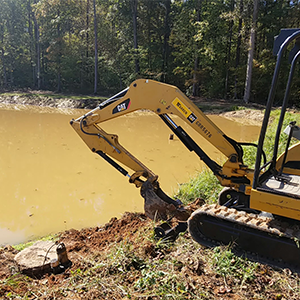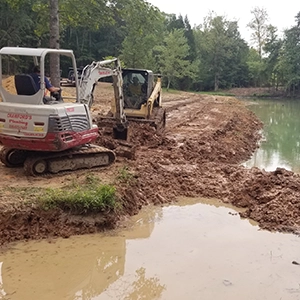Stormwater Retention Pond Construction in North Carolina

Stormwater Control Solutions are more critical than ever, with rising urban development and unpredictable weather patterns increasing the need for effective stormwater control solutions. Retention ponds are a proven solution for managing stormwater, reducing flooding, and improving water quality. If you’re a property owner or manager in North Carolina, we want to help you understand who regulates the maintenance, and construction of stormwater ponds. It is important to comply with local and state laws to ensure your pond is healthy, structurally sound, and will perform effecitvely for many years to come.
This guide will walk you through the key features, steps, and regulations involved in stormwater retention pond construction in North Carolina.
WHATS IN THIS BLOG?
o Introduction
o What is a Retention Pond and Why Does Your Property Need One?
ο Not all Ponds are the same. Pond Construction is based on the pond owners needs.
ο Steps to Constructing a Stormwater Retention Pond
ο 1. Perform a Site Assessment
ο 2. Understand the Regulatory Guidelines in North Carolina
ο 3. Design Your Pond
ο 4. Prepare the Site
ο 5. Construct The Stormwater Retention Pond
ο 6. Test and Finalize
ο Regulations for Retention Ponds in North Carolina
ο Conclusion: Build a Retention Pond That Works for Your Property
What is a Retention Pond, and Why Does Your Property Need One?
A stormwater pond, also known as a wet detention pond, is a water collection system designed to collect and retain stormwater runoff. Unlike dry detention ponds, retention ponds maintain a permanent pool of water, which helps to filter polluted water, prevents erosion, and minimizes flooding.
Properties of all sizes benefit from retention ponds, especially in areas prone to heavy rainfall and have parking lots or other structures that produce polluted stormwater run off. State and local laws typically require a retention pond for developments, parking lots, and industrial areas in order to comply with stormwater regulations. Pond Lake Management is a Pond Management expert working from Greensboro, NC, we can help you with pond construction and pond maintenance.
Not all Ponds are the same. Stormwater Retention Pond Construction is based on the pond owners needs.
The design of a retention pond can vary depending on factors such as property size, type of runoff, and drainage demands from stormwater runoff. While all retention ponds share some common features, such as inlet and outlet structures, the specifics often depend on local requirements and the size of the property.
Key features of stormwater retention ponds include:
- Permanent Pond With a Pool Of Water: This basin holds water at all times, helping to settle sediments and improve water quality.
- Outlet Drains/Pipes: These drains and pipes regulate the release of water to maintain consistent pond levels and prevent flooding downstream.
For smaller ponds servicing residential or low-impact areas, a smaller pond with fewer pond features may be appropriate, while larger or heavily utilized properties often require advanced controls, such as reinforced structures or larger ponds for water storage .
1. Perform a Site Assessment
Each site is unique, and its characteristics—including soil type, topography, and drainage patterns—will impact the design of your pond. Conduct a thorough survey with a pond construction professional to identify the most suitable location to build your retention pond. Avoid areas with shallow bedrock, which will make construction more difficult and reduce the ponds ability to store water.
2. Understand the Regulatory Guidelines in North Carolina
Before moving forward, familiarize yourself with North Carolina’s stormwater management regulations. State and local governments enforce stormwater retention pond construction guidelines to ensure retention ponds are safe, and working properly. Permitting involves collaborating with local and state environmental agencies, such as the North Carolina Department of Environmental Quality (NCDEQ).
Key regulatory points include:
The minimum size and storage requirements for different zones, and properties
Water quality standards for runoff
Specifications for buffers, setbacks, and vegetative coverings
Sediment and erosion control plans during construction
Penalties for non-compliance can be expensive, so make sure you are following local laws and guidelines.
3. Design Your Pond
Once the site assessment and permitting are complete, work with at the team at Pond Lake Management to design the pond. Your design should accommodate peak stormwater flows while meeting North Carolina’s requirements for water storage and water discharge.
4. Prepare the Site
Begin by installing temporary sediment and erosion control measures to protect neighboring properties during construction. These temporary features may include silt fences, sediment barriers, and check dams. Excavation can now begin. Follow the pond professional’s design plans closely to achieve proper grading and slope.
5. Construct the Stormwater Retention Pond
Once excavation is complete:
- Install the inlet and outlet pipes to properly manage water flow.
- Build safety benches along the perimeter.
- Add trash bar guards near inflow points to capture debris.
- Plant vegetative buffers around the pond for added stability, and water filtration.
These features not only improve the pond’s ability to filter out pollutants and control water runoff but also ensure compliance with local guidelines.
6. Test and Finalize
Before wrapping up the project, test the pond’s components to ensure they are functioning properly. Verify that water levels, overflow structures, and outflows match the design plans. Any features that are not functioning correctly should be addressed before stormwater retention pond construction is completed.
Regulations for Retention Ponds in North Carolina
North Carolina’s regulations for retention ponds are some of the most thorough in the country.
Key points to keep in mind include:
- Stormwater Control Measures (SCMs): Your retention pond must meet state standards. This includes meeting performance benchmarks for both water quantity and quality.
- Buffer Zones: Natural vegetative buffers are mandatory to protect surrounding ecosystems.
- Pond Maintenance Agreements: Owners are typically required to sign a maintenance agreement, ensuring long-term care for features like forebays and outlet pipes.
- Erosion and Sediment Control Permits: All phases of construction must comply with sediment control laws during site preparation and grading.







